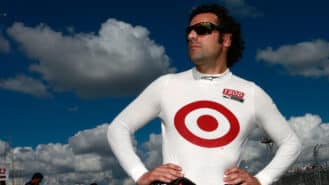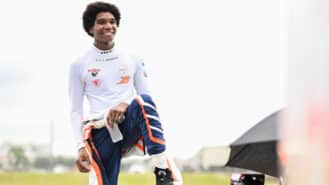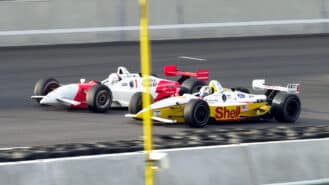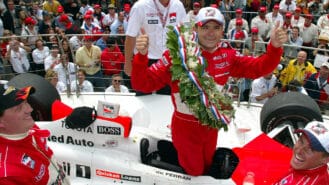Roger Penske’s IndyCar team won last year’s IndyCar championship with Will Power and is again enjoying a strong season. Juan Pablo Montoya scored the team’s 16th Indy 500 victory in May and with only four races to go he’s comfortably leading the championship in pursuit of the team’s 14th Indycar title. But over the years Penske’s team enjoyed many seasons that were considerably more successful. Four or five years jump to mind, including 1968, ’72, ’79, ’88 and ’94. Which was the best?

1968
Penske started his team in 1966 competing in the United States Road Racing Championship and the Can-Am series with a Lola-Chevy T70 driven by Mark Donohue and sponsored by Sunoco. Donohue scored the team’s first win in a USRRC race at Kent, just outside Seattle, in July of ’66 and also won Mosport’s Can-Am race in September. The following year Donohue won the USRRC title, winning six of eight races, and finished fourth in the Can-Am championship.

Donohue at Riverside, 1968
In 1968 Donohue won the USRRC title for the second year in a row, winning five races at Riverside, Laguna Seca, St Jovite, Watkins Glen and Mid-Ohio. He also dominated in Trans-Am, winning nine of 16 races and taking the championship driving a Penske/Sunoco Chevrolet Camaro.
Donohue was less successful in the Can-Am series, winning just once at Bridgehampton, but his results in the USRRC and Trans-Am established Penske’s reputation as one of America’s leading racing teams. In 1969 Donohue won the Trans-Am championship again teamed with Ronnie Bucknum in a pair of Chevy Camaros and two years later Donohue took the Trans-Am title a third time driving an AMC Javelin.
An important historical note from 1968 was that Donohue and Penske made their USAC Championship debut at Mosport in June. Driving an Eagle-Chevy, Donohue finished sixth in the first 100-mile race and fourth in second race, taking fifth overall.
1972
This was a significant year for Penske Racing, because Donohue won the Indy 500 for the first time in only the team’s fourth attempt. After winning Indy, Donohue broke his leg in a big accident while testing a Porsche 917/10 Can-Am car at Road Atlanta. He was sidelined for a few months and replaced by George Follmer, who went on to take Penske’s first Can-Am championship, winning five of nine races.

Follmer at Watkins Glen, 1972
Donohue returned in September in a second car and won at Edmonton. The following year he dominated the Can-Am series aboard Penske’s Porsche 917/30, qualifying on the pole at all eight races and winning six of them.
From the archive: Mark Donohue, the prototype modern racing driver (2005)
1979
Without doubt one of Penske’s best seasons came in 1979. Rick Mears scored his first Indy 500 victory and also won the first CART championship for Penske’s third Indycar title in a row after Tom Sneva won the USAC championship in 1977 and ’78. Mears won two other races in ’79 while team-mate Bobby Unser scored five wins, including the California 500 at the Ontario Motor Speedway where Mears and Mario Andretti finished second and third for Penske’s first 1-2-3 sweep.
Over the next few years Penske was the team to beat, although Johnny Rutherford won the 1980 Indy 500 and CART title aboard Jim Hall’s Chaparral 2K. Bobby Unser won the Pocono and California 500s for Penske and Unser and Mears combined to score seven wins and take poles from 14 races that year.
The following year, 1981, Unser won the Indy 500 and Mears took his second CART title. Between them Mears and Unser won seven races and took six poles in ’81 while Mears won his third CART championship in 1982, although he lost the Indy 500 by a whisker to Gordon Johncock in one of the big race’s most exciting finishes.

Mears at Indianapolis, 1979
Al Unser won the championship again for Penske in 1983 and ’85, scoring the team’s sixth and seventh Indycar titles – over a nine-year stretch from 1977-85, Penske was beaten to the championship only twice, by Rutherford and the Chaparral team in 1980 and by Mario Andretti and Newman/Haas in ’84.

1988
Another big year for Penske came in 1988 when Mears won his third Indy 500 and Danny Sullivan won the CART championship for Penske’s eighth Indycar title in 12 years. Sullivan took nine poles in ’88 and Mears added four more, Indy 500 included. Sullivan led 517 laps over the season and Mears 475. They combined for six wins and 13 poles from 15 races.
This was also the first year Nigel Bennett designed Penske’s cars and over the next 10 years Bennett produced a long line of successful and beautiful Indycars. That was also the year Ilmor’s new Chevrolet turbo V8 seriously hit its stride after first racing in 1985.
Mears scored his fourth Indy 500 win in 1991 before retiring at the end of the ’92 season. Rick was replaced by a young Paul Tracy and in 1993 Emerson Fittipaldi scored Penske’s eighth Indy 500 win as he and Tracy finished second and third in CART’s championship to Nigel Mansell and Newman/Haas. Between them, Fittipaldi and Tracy won eight of 16 races in ’93.
From the archive: Lunch with Rick Mears (2013)

Sullivan at Long Beach, 1988
1994
Then came 1994, which stands out as Penske’s greatest season. Al Unser Jr joined the team and three cars were run in all 16 races. A special 209ci single-cam, rocker arm Mercedes-Benz engine, known as ‘The Beast’, was designed by Mario Illien and built by Ilmor specifically for the Indy 500, where Unser came through to win after Fittipaldi crashed while leading late in the race.
Back with its regular CART-spec four-cam Ilmor engines for the rest of the season, Unser, Fittipaldi and Tracy totally dominated with Nigel Bennett’s PC23. Unser won the championship, his second and Penske’s ninth Indycar title, while Fittipaldi and Tracy finished second and third in the standings, recording the first and only 1-2-3 championship sweep by a team in the 100-plus-year history of Indycar racing.
Unser won eight races and took four poles in ’94. Tracy won three times and added four more poles while Fittipaldi won once and took two poles. In total Penske’s trio accumulated 12 wins and 10 poles from 16 races that year. Between them, Unser, Fittipaldi and Tracy led 1548 of the season’s total of 2083 laps. They also recorded five 1-2-3 sweeps at Milwaukee, Portland, Mid-Ohio, New Hampshire and Nazareth, something no team has done before or since.
Karl Kainhofer was Penske Racing’s chief mechanic from 1966-75 and ran the team’s engine shop from 1977 through his retirement in 1997. He puts 1994 into perspective.
“Winning Indy is always a big thing and doing it with ‘The Beast’ made it even bigger for many people,” Kainhofer says. “But for me, winning all those races and scoring those five 1-2-3 sweeps meant a lot.

Jr with a proud Sr, Indianapolis, 1994
“The ’94 season was a history-making year for Penske Racing, and for the sport,” Kainhofer adds. “We had a great year in 1968 when we were still a small team, and 1979 with Mears was a real good year. We also had a great season in 1988 with Sullivan and Mears, but 1994 really was the best of all because we achieved so much with three cars.”
From 1977-99 Penske Racing built its own cars and engines, including Cosworths, Ilmor/Chevrolets, Mercedes-Benz and Ilmors. In 1994 the team’s engine shop turned out more than 50 engines to supply Unser, Tracy and Fittipaldi, but changing political times meant Penske would soon begin racing production cars from the likes of G Force and Dallara and engines supplied by outside manufacturers.
In 2000 and ’01 Gil de Ferran won back-to-back CART championships for Penske and set a closed course speed record at 241.438mph in qualifying for the 2000 California 500, but by then the team was no longer building its own cars or engines.
De Ferran and team-mate Hélio Castroneves raced Reynard-Hondas in 2000 and ’01. The Reynards were extensively reworked and improved with Penske’s own suspension, bodywork and driveline components. But in 2002 Penske made his move to the IRL and as successful as the team has continued to be, we haven’t seen anything like the 20-year stretch when the team built and developed its own cars and engines.
Last year Penske finished first, second and fourth in IndyCar’s championship with Will Power, Hélio Castoneves and Montoya who combined to win five races and take eight poles. This year the team is equally strong but its achievements pale in comparison to the remarkable list of Penske Racing’s accomplishments from 1968, ’72, ’79, ’88 or ‘94.
From the archive: Breakfast with Roger Penske (2010)











